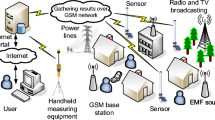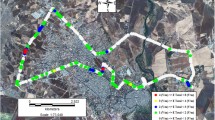Abstract
Following an increasing number of artificial electromagnetic field (EMF) sources in human surrounding, a number of research studies have been devoted to the issue of environmental EMF pollution. A particular attention has been attributed to the highly sensitive EMF zones, where people can stay for a longer period of time, which, among others, includes university campuses. Thus, the modern approach of long-term EMF monitoring has been established, carrying out cumulative field strength measurements at locations that are most visited by student population and university staff. The goal was to establish periodic and systematic EMF investigation over such highly sensitive areas, through a standardized procedure for EMF monitoring. In this paper, details about two EMF monitoring campaigns over the University of Novi Sad campus were presented, performing comparative analysis of their results. The obtained results revealed the increase (up to four times) of the cumulative field strength values, as well as the general population exposure, at specific locations. Between these two campaigns, the emergence of the new base station, as well as numerous Wi-Fi networks, was noticed in the campus. Consequently, the highest field strength values were acquired at two locations, most directly exposed to the main beams of base station’s antennas, although all obtained values were at least five times lower than the minimal reference levels prescribed by the Serbian legislation. Even though such results are acceptable, the future monitoring campaigns should be planned, particularly since the installation of new EMF sources are expected in the campus of the University of Novi Sad.









Similar content being viewed by others
References
As N, Dilek B, Şahin ME, Karan Y (2014) Electromagnetic pollution measurement in the RTE university campus area. Glob J Adv Pure Appl Sci 3:65–72
Calvente I, Fernández MF, Pérez-Lobato R, Dávila-Arias C, Ocón O, Ramos R, Ríos-Arrabal S, Villalba-Moreno J, Oleaa N, Núñez MI (2015) Outdoor characterization of radio frequency electromagnetic fields in a Spanish birth cohort. Environ Res 138:136–143. https://doi.org/10.1016/j.envres.2014.12.013
Djuric N, Kljajic D, Kasas-Lazetic K, Milutinov M, Prsa M, Bajovic V, Pekaric-Nadj N, Milosevic V (2013) The concept of the SEMONT monitoring system and its influence on the EM pollution protection, IEEE AFRICON 2013 conference, Mauritius, 9-12 September 2013, pp. 1298-1302
Djuric N, Kljajic D, Kasas-Lazetic K, Bajovic V (2014) The measurement procedure in the SEMONT monitoring system. Environ Monit Assess 186(3):1865–1874. https://doi.org/10.1007/s10661-013-3500-0 Print ISSN: 0167–6369, Online ISSN: 1573–2959
Djuric N, Kljajic D, Kasas-Lazetic K, Bajovic V (2015) The SEMONT continuous monitoring of daily EMF exposure in an open area environment. Environ Monit Assess:187–191. https://doi.org/10.1007/s10661-015-4395-8 print ISSN: 0167-6369, online ISSN: 1573-2959
Eurobarometer 347, Special Eurobarometer 347, Eurobarometer 73.3, “Electromagnetic Fields” (2010) (http://ec.europa.eu/public_opinion/archives/ebs/ebs_347_en.pdf). Accessed March 2019
Gajsek P, Ravazzani P, Wiart J, Grellier J, Samaras T, Thuróczy G (2015) Electromagnetic field exposure assessment in Europe radiofrequency fields (10 MHz–6 GHz). J Expo Sci Environ Epidemiol 25(1):37–44
Gallastegi M, Huss A, Santa-Marina L, Aurrekoetxea JJ, Guxens M, Birks LE, Ibarluzea J, Guerra D, Röösli M, Jiménez-Zabala A (2018) Children's exposure assessment of radiofrequency fields: comparison between spot and personal measurements. Environ Int 118:60–69. https://doi.org/10.1016/j.envint.2018.05.028
ICNIRP (1998) International commission on non-ionizing radiation protection (ICNIRP) – guidelines for limiting exposure to time-varying electric, magnetic, and electromagnetic fields (up to 300 GHz), http://www.icnirp.de/documents/emfgdl.pdf. Accessed March 2019
ITU K.83 (2011) ITU K.83 – Monitoring of electromagnetic field levels, 03/2011
Joseph W., Verloock L., Goeminne F., Verlaek M., Constandt K. and Martens L. (2014). In-situ RF exposure in schools, houses, and public places, joint meeting of the Bioelectromagnetics society and the European BioElectromagnetics association (BioEM 2014), Cape Town, South Africa, 8-13 June 2014, pp. 427-430
Karipidis K, Henderson S, Wijayasinghe D, Tjong L, Tinker R (2017) Exposure to radiofrequency electromagnetic fields from Wi-fi in Australian schools. Radiat Prot Dosim 175(4):432–439. https://doi.org/10.1093/rpd/ncw370
Karpowicz J, De Miguel-Bilbao S, Zradzńnski P, Gryz K, Falcone F, Ramos V (2018) Comparative study of radiofrequency electromagnetic exposure in the public shopping centers, IEEE international symposium on electromagnetic compatibility (EMC Europe 2018), Amsterdam, the Netherlands, 27-30 august 2018, pp. 972-975
Kljajic D, Djuric N (2016) The adaptive boundary approach for exposure assessment in a broadband EMF monitoring. Measurement 93:515–523. https://doi.org/10.1016/j.measurement.2016.07.055
Kunter FC (2015) Students exposure to radio frequency electromagnetic fields in Marmara University. Marmara Sci J 27(1):32–36. https://doi.org/10.7240/mufbed.70492
Kurnaz C (2018) An empirical modeling of electromagnetic pollution on a university campus, Applied Computational Electromagnetics Society. Newsletter 33(1):111–114
Narda (2006a) Narda safety test solutions GmbH, NBM-550 broadband field meter User’s guide, Narda, https://www.narda-sts.us/pdf_files/NBM-550_Manual.pdf. Accessed March 2019
Narda (2006b) Narda safety test solutions GmbH, EF 0691 electric field User’s guide, Narda, https://www.narda-sts.com/en/wideband-emf/nbm-550/nbme-field-6-ghz/eID/pd/pdce/12716/pdfr/2249, accessed in March 2019
Regulation (2009). Regulation on the limits of exposure to non-ionizing radiation, the law of the Republic of Serbia, no 104/09
Rowley JT, Joyner KH (2012) Comparative international analysis of radiofrequency exposure surveys of mobile communication radio base stations. J Expo Sci Environ Epidemiol 22(3):304–315
Sagar S, Dongus S, Schoeni A, Roser K, Eeftens M, Struchen B, Foerster M, Meier N, Adem S, Röösli M (2017) Radiofrequency electromagnetic field exposure in everyday microenvironments in Europe: a systematic literature review. J Expo Sci Environ Epidemiol 28(2):147–160
SEMONT website (2019) http://semont.ftn.uns.ac.rs. Accessed March 2019
Seyfi L (2013) Measurement of electromagnetic radiation with respect to the hours and days of a week at 100 kHz – 3 GHz frequency band in a Turkish dwelling. Measurement 46(9):3002–3009
SRPS EN 50413:2010 (2010) Basic standard on measurement and calculation procedures for human exposure to electric, magnetic and electromagnetic fields (0 Hz – 300 GHz), https://www.iss.rs/rs/standard/?natstandard_document_id=24271. Accessed March 2019
SRPS EN 50492:2010 (2010) Basic standard for the in-situ measurement of electromagnetic field strength related to human exposure in the vicinity of base stations, https://www.iss.rs/rs/standard/?natstandard_document_id=24272. Accessed March 2019
Temaneh-Nyah C, Victor E (2015) RF radiation exposure levels from the Valombola base station, in the faculty of engineering and IT vicinity, Ongwediva, Namibia, IEEE 2015 international conference on emerging trends in networks and computer communications (ETNCC), Windhoek, Namibia, 17-20 may 2015, pp. 27-31
Van Wel L, Vermeulen R, Van Eijsden M, Vrijkotte T, Kromhout H, Huss A (2017) Radiofrequency exposure levels in Amsterdam schools. Bioelectromagnetics 38(5):397–400. https://doi.org/10.1002/bem.22053
Verloock L, Joseph W, Goeminne F, Martens L, Verlaek M, Constandt K (2014a) Temporal 24-hour assessment of radio frequency exposure in schools and homes. Measurement 56:50–57
Verloock L, Joseph W, Goeminne F, Martens L, Verlaek M, Constandt K (2014b) Assessment of radio frequency exposures in schools, homes, and public places in Belgium. Health Phys 107(6):503–513
Wavecontrol (2016a). Wavecontrol SMP2 Electromagnetic Field Meter and Spectrum Analyzer, Wavecontrol, https://www.wavecontrol.com/rfsafety/images/data-sheets/en/SMP2_Datasheet_EN.pdf. Accessed March 2019
Wavecontrol (2016b). Wavecontrol WPT Field probe for Mobile frequency bands, Wavecontrol, https://www.wavecontrol.com/rfsafety/images/data-sheets/en/WPT_Datasheet_EN.pdf. Accessed March 2019
WHO (2010). World Health Organization – WHO research agenda for radiofrequency fields, https://apps.who.int/iris/bitstream/handle/10665/44396/9789241599948_eng.pdf?sequence=1&isAllowed=y. Accessed March 2019
Funding
This paper is supported by the Ministry of Education, Sciences and Technological Development of the Republic of Serbia through the project TR 32055.
Author information
Authors and Affiliations
Corresponding author
Ethics declarations
Ethical approval
This article does not contain any studies with human participants or animals performed by any of the authors.
Additional information
Responsible editor: Philippe Garrigues
Publisher’s note
Springer Nature remains neutral with regard to jurisdictional claims in published maps and institutional affiliations.
Rights and permissions
About this article
Cite this article
Kljajic, D., Djuric, N. Comparative analysis of EMF monitoring campaigns in the campus area of the University of Novi Sad. Environ Sci Pollut Res 27, 14735–14750 (2020). https://doi.org/10.1007/s11356-020-08008-8
Received:
Accepted:
Published:
Issue Date:
DOI: https://doi.org/10.1007/s11356-020-08008-8




